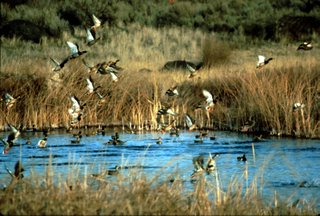With the close of fishing season on November 30 concluded The Nature Conservancy’s 30th anniversary year at Silver Creek Preserve. During the fishing season, which opened May 27, the preserve attracted 7301 visitors representing every U.S. state and 13 countries.
Almost half (49 percent) of all visits were from out-of-state guests Visitors came to the preserve from Austria, England, Japan, France, Switzerland, Canada, Mexico, Australia, Argentina, Germany, Turkey, New Zealand and Peru. The preserve is considered a worldwide fly-fishing destination due to its tremendous insect hatches, an incredible trout population and very visible—but hard to catch—trophy fish.
In fact, 89 percent of the visitors to the preserve came to fish. About 18 percent used one of the five guide services that operate on Silver Creek. The rest of the visitors enjoyed birding, hiking and canoeing on the 880-acre property.
While some of the hatches changed this season due to early high water, anglers found excellent an excellent trico hatch and a strong fish population. The largest trout ever recorded caught on the creek, a 33-inch brown, was landed this summer by a former Silver Creek intern.
The preserve was created 30 years when The Nature Conservancy purchased the 479-acre property known as Sun Valley Ranch. The ranch had been up for sale and Jack Hemingway—son of Ernest Hemingway and a commissioner for the Idaho Department of Fish and Game—believed the property should be preserved for future generations. Hemingway sought the Conservancy to purchase the property as a nature preserve.
An important part of the conservation success along Silver Creek has been the donation of conservation easements by other landowners in the valley. To date, 22 landowners have donated nearly 10,000 acres of easements, protecting nearly the entire main stem of Silver Creek from development.
“The number of visitors that enjoy Silver Creek each year is a great testament to the conservationists who worked so hard to make this preserve possible,” says Dayna Smith, Silver Creek preserve manager. “They have created a tremendous conservation legacy in this valley. Future generations from all over the globe will be able to continue to enjoy world-class fishing, abundant wildlife and a rural setting due to their hard work and vision.”
The Conservancy hosted activities throughout the season to celebrate the preserve’s anniversary, including a gala event for the preserve’s founders at nearby Loving Creek Ranch, an opening weekend barbecue, nature walks and educational seminars. The organization also published a commemorative booklet, available free at the preserve and the Conservancy’s state headquarters in Hailey.
While the fishing season and anniversary celebrations are over for the year, the preserve remains open to public use.
“It is truly a beautiful time of year to be here,” says Smith. “Waterfowl have congregated in the wetlands, bald eagles fly overhead and the winter light is stunning.”
The Conservancy has ambitious plans for the preserve and Silver Creek watershed in the coming years. Uplands habitat restoration, a study looking at sediment and temperature issues in Kilpatrick Pond, stream bank enhancements, birding and nature walks, and a symposium to discuss Silver Creek and Big Wood conservation issues are a few of the things planned for 2007.
“By working together, we can ensure that the preserve continues to be a special place for people and nature,” says Smith. “The Nature Conservancy thanks the many people who contributed to the preserve over the past thirty years. We look forward to continuing to work with the community to protect this place for many, many decades to come.”














 Rancher and conservationist Warner Glenn signs a poster of his latest jaguar photo, taken near his ranch in southern Arizona.
Rancher and conservationist Warner Glenn signs a poster of his latest jaguar photo, taken near his ranch in southern Arizona.

 At other times of year, visitors may see javelina, coati, black bear and a tremendous variety of birds. The preserve includes several ponds, constructed to mimic wetlands that once were found in this valley, located along the stream. These ponds are part of a project to conserve Ramsey canyon leopard frog, a rare species found nowhere else on earth. These frogs can be easily seen during a visit.
At other times of year, visitors may see javelina, coati, black bear and a tremendous variety of birds. The preserve includes several ponds, constructed to mimic wetlands that once were found in this valley, located along the stream. These ponds are part of a project to conserve Ramsey canyon leopard frog, a rare species found nowhere else on earth. These frogs can be easily seen during a visit.






























